Ijraset Journal For Research in Applied Science and Engineering Technology
- Home / Ijraset
- On This Page
- Abstract
- Introduction
- Conclusion
- References
- Copyright
Waste Spillover Monitoring System using Arduino
Authors: Korukanti Ashray, Kavali Poornoday, Yeravelli Manideep, T. Venkat Rao
DOI Link: https://doi.org/10.22214/ijraset.2022.40797
Certificate: View Certificate
Abstract
In recent years, urban development plans and the notion of smart cities have grown significantly. While the idea of smart cities is being addressed, there is a need for smart waste management. The waste spillover monitoring system is designed for smart buildings. Colleges, hospitals, and bus stops are just a few examples. The waste spillover monitoring system is developed to prevent waste mismanagement and promote community cleanliness. A waste spillover monitoring system is a novel concept in which an ordinary dustbin is made smart by employing ultrasonic sensors to detect garbage levels, display the information on an LCD, and send a message to the responsible department through a GSM modem, updating the state of the bin. When individuals bring trash to the waste bin while it is full, it prevents them from adding any more garbage to the bin by notifying them with a buzzer alert. The GSM and the peripheral sensors used are interfaced through the Arduino micro-controller. A graphical user interface (GUI) is also being created to track the needed garbage bin information for various locations. At the control room, messages received via GSM are shown on an LCD, and the authorized person informs the drivers to collect the waste on time. This will significantly aid in the monitoring of waste collection in order to maintain a smart, clean, and safe environment.
Introduction
I. INTRODUCTION
In Ethiopian society, it is claimed and valued that people "learn cleanliness from the cat." Beyond this proverb, the scenario is that keeping the environment clean is very important, and it is often used to emphasize the importance of cleanliness. However, successfully and properly managing the rubbish is not as simple as reciting the aphorism. In several Ethiopian cities, we frequently see garbage bins overflowing with more waste materials being disposed of and accumulating around the bin. Garbage! We see photographs of rubbish bins that are overflowing and the stench of waste in our daily lives out. As a result, a high number of insects and mosquitoes nest on it, increasing the number of diseases. A significant amount of Solid waste management is a challenge for smart cities in practically every country in the world, not only India. This project outlines the most effective methods for maintaining a clean and green environment. The approaching big event number of smart cities, large numbers of responsibilities is also required to be fulfilled. The The most crucial requirement of a wise way of life is cleanliness, and cleanliness begins with smart dustbin. Only if the dustbins are correctly positioned and collected will a people's garbage be appropriately dispatched .The fundamental issue with most cities' current waste management systems is the hazardous state of the waste. dustbins. As a result, we use modern technology to send information to those who need it and to show it. In the concern offices, boards are arranged. It is possible to trace the flow of rubbish around the city. As a result, they may be efficiently and concretely monitored by a single system. This system has the potential to be successful.
II. METHODOLOGY
The level of waste in the dustbins is detected using Sensor systems and reported to the approved control room via GSM system in a "Waste spillover monitoring system." To connect the sensor system to the GSM system, a micro-controller is used. The Ultrasonic sensor is utilised in this system to measure garbage level via ultrasonic sound waves. When the garbage is not cleaned, the GSM module is utilised to transmit a message to higher authority. The location of the dustbin is full gets displayed on an LCD in the control room. The sensor, LCD, and GSM module are all connected using an Arduino board. The ultrasonic sensor serves as a level gauge. The level gauge's output is connected to the micro-controller. The first test is run when the garbage bin is empty or has a very low garbage level, according to the micro-controller programming. Neither the green nor the red LED's are illuminated. If the bin is then loaded with more waste until it has reached the initial threshold value, which is set at 20%. The first Red LED is almost certain to turn on. The second threshold value, which is set at 40%, is then exceeded. The second Red light is now turned on. Similarly, the third value, which is at 60%, is identical. The bin is then completely full, and the garbage level has now surpassed the fourth threshold level, which is set at 100% of the bin height.
As a result, the red LED has turned on, and the warning buzzer has been activated, alerting the municipality and the neighboring communities. The AT commands are used to make the GSM Module's messaging service easier to use. With the help of Arduino software, this programme gets burned into the micro-controller (IDE). These notifications contain information about the garbage levels in the individual trash cans. The authority tells the concerned person of the appropriate area about the garbage level based on the information given to the control room. The concerned individual then ensures that the waste in that specific location is removed by dispatching cleaning vans.
III. REQUIREMENTS
A. Hardware
The hardware requirements for the system are as follows:
1. Ultrasonic Sensors: Detecting the level of Garbage.
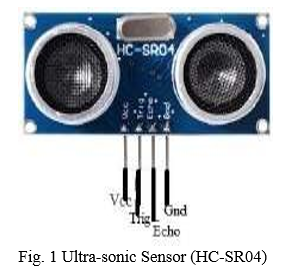
The Ultrasonic Sensor emits a high-frequency sound pulse and then measures the time it takes for the sound's echo to return. On the front side of the sensor, there are two slots. Ultrasonic waves are transmitted via one outlet and received through the other. In the air, sound travels at a speed of around 341 metres (1100 feet) per second. This information, coupled with the time delay between sending and receiving the sound pulse, is used by the ultrasonic sensor to calculate the distance to an item. It uses the following mathematical formula:
Distance = (Time x Speed of Sound)/2
Time = The time between the transmission and reception of an ultrasonic wave.

The time from transmission of a pulse to reception is measured and translated into an arrangement by knowing the speed of sound to determine the distance to a target. This signal, along with noise, is then subjected to various types of signal processing, which for basic sensors may consist of nothing more than energy measurement.The data is then fed into a decision mechanism, which determines whether the output is the needed signal or noise. This decision device could be a person wearing headphones or looking at a screen, or it could be software in some systems. Additional operations to categorise and locate the target, as well as to measure its velocity, may be carried out. Some ultrasonic sensors feature numerous beams to offer all-around coverage, but others just cover an arrow arc, although the beam can be rotated slowly by mechanical scanning.
2. GSM Modem: GSM Modem accepts SIM cards from any GSM network operator and functions as a mobile phone with its own unique phone number. The advantage of using this modem is that you can communicate and develop embedded applications using its RS232 interface. As demonstrated below, GSM can be used to implement applications such as SMS control, data transfer, remote control, and logging.
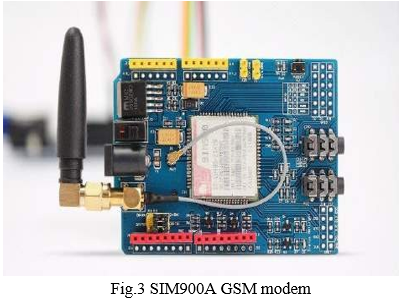
RS232 can be used to link the modem to the Arduino micro-controller. It can send and receive SMS as well as make and receive voice calls. It can also connect to the internet through GPRS and run a variety of data logging and control apps. This GSM modem is a plug-and-play quad-band SIM900A GSM modem that allows for direct and simple integration with RS232 applications. Voice, SMS, Data/Fax, GPRS, and an integrated TCP/IP stack are all supported.
3. Liquid Crystal Display (LCD):
To display the dustbin level status.
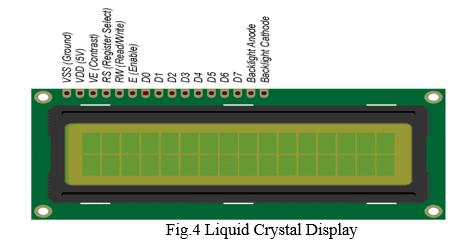
A liquid crystal display (LCD) is a display module that uses liquid crystals as well as LED's for back-lighting. A 16x2 LCD panel has two rows of characters, each of which is 16 characters long. The LCD Module has 16 pins and runs on 5V. Pins 1, 2, 3, 15, and 16 are utilised to deliver power to both the module and the backlight LED's. When the POT is modified, the voltage to the Contract Adjust Pin (Pin 3 or VEE) is normally provided by a Potentiometer, which controls the contrast of the actual display.There are 8 data pins that can transfer 8 bits of data at a time, or 1 byte of data. You can use the LCD in either 8bit or 4bit mode. The remaining three pins, RS (Pin 4), RW (Pin 5) and E (Pin 6) are referred to as the Control Pins and are crucial. When the RS pin is LOW, it selects either the Instruction Register or the Data Register, and when it is HIGH, it selects both.The RW pin, often known as the Read/Write Pin, is used to select Read or Write Mode. The read mode is selected when RW is HIGH, and data is read from the register. Write mode is selected when RW is LOW, and data can be written into the register. We can connect the RW pin to ground because we're only using the write mode (through a pull down resistor). The Enable (E) pin is used to enable the execution of data or instructions, as its name suggests. Only when a HIGH to LOW pulse is delivered to the Enable pin, i.e. only on the falling edge of a pulse, can the LCD module execute the data or command.
4. ARDUINO UNO R3 ATMEGA 328P: The Arduino ATMega 328p is a micro-controller board based on the ATmega328p, as seen in Figure 5. A 16 MHz crystal oscillator, 54 digital input/output pins (of which 15 can be used as PWM outputs), 16 analogue inputs, 4UARTs (hardware serial ports), a USB connection, a power jack, an ICSP header, and a reset button are all included. It comes with everything you'll need to get started with the micro-controller; simply plug it into a computer with a USB cable or power it with an AC-to- DC adapter or battery. The ability to operate several appliances from a single board is a significant benefit.
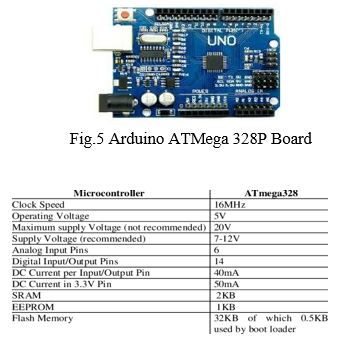
B. Software Requirements
- Arduino IDE: The Arduino software is an open source Integrated Development Environment (IDE) . It includes a code editor, a message area, a text console, a toolbar with typical function buttons, and a series of menus.
- Writing sketches: Arduino sketches are programme made with the Arduino software.(IDE). These sketches were created with a text editor and saved with the.ino file extension. The message section indicates faults and provides feedback while storing and exporting. The Arduino Software (IDE) outputs text to the console, which includes detailed error messages and other information. The configured board and serial port are displayed in the window's bottom right corner. You may validate and upload programme, generate, open, and save sketches, and open the serial monitor using the toolbar buttons. The Arduino Language is simple to use and consists of a set of C/C++ functions that may be invoked from your code.
IV. DESIGN AND IMPLEMENTATION
The project is divided into two modules, the first of which is the detection of waste levels, and the second of which is the transmission of the data to the appropriate officials through GSM.
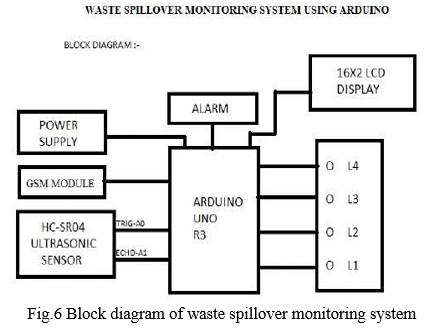
Ultrasonic sensors (HC-SR04) are used to detect garbage levels. The ultrasonic sensors are mounted on the top of the dustbin, pointing down. The sensors continually generate sonic waves, which hit the item and reflect back, enabling the echo in the sensors to detect the waves and calculate the object's distance. The Arduino ATMega 328p is used to control the entire process of detecting garbage in various locations and, depending on the programme, first displaying the garbage level in the bin on the LCD, even though the garbage is not removed from the bin, and then sending the specific bin information to higher officials via GSM.
V. RESULT AND DISCUSSION
The major goal of the waste spillover monitoring system based on IOT is to save time and money while also improving the city's smart vision. The environment is clean and hygienic, and environmental cleanliness is ensured by employing a sensor and GSM. Household waste is improperly disposed of and stored, resulting in public health and pollution issues. GSM will help in sending the message to the municipal authorities with the current location. Smart Garbage Monitoring System using IOT is built using ultrasonic sensor as distance measuring sensor, and GSM will aid in sending the message to the municipal authorities with the current location. The Arduino IDE was used to create the Smart Garbage Monitoring System using IOT.
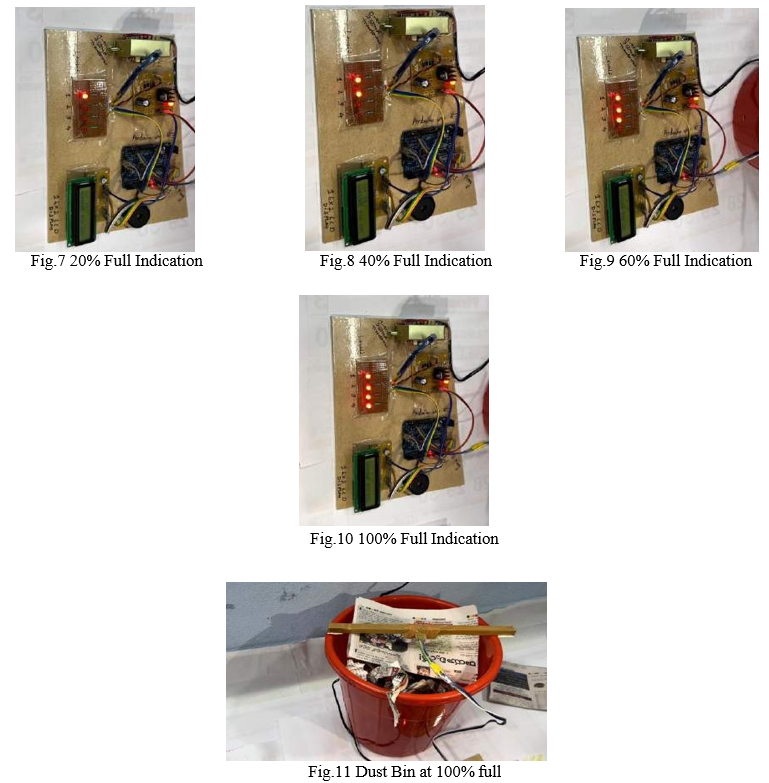
Conclusion
Smart buildings necessitate waste spillover monitoring systems. Smart waste spillover management and monitoring is a brilliant idea from smart city planners. waste spillover monitoring systems are a novel concept in which a standard dustbin is made smart by employing sensors to detect garbage levels and sending a message to the user to inform them of the bin\'s status. When the dustbin is full, it displays the information on an LCD and sends a notification to the appropriate officials.
References
[1] “Smart garbage management system” International Journal of Engineering Research &Technology (IJERT) ISSN:2278-0181. [2] “Smart Dustbin” National Conference on Product Design (NCPD 2016), July 2016. [3] http://www.instructables.com/id/Smart-Garbage-Can-for-a-Smart-City/ [4] S.S. Navghane, M.S. Killedar, Dr.V.M. Rohokale,\" IoT Based Garbage and Waste Collection Bin\", May 2016 [5] Kasliwal Manasi H and Suryawanshi Smithkumar B 2016 A Novel approach to Garbage Management Using Internet of Things for smart cities International Journal of Current Trends in Engineering & Research 2 348-53. [6] Anitha A, Paul G and Kumari S 2016 A Cyber defence using Artificial Intelligence International Journal of Pharmacy and Technology 8 25352-57. [7] Monika K A, Rao N, Prapulla S B and Shobha G 2016 Smart Dustbin-An Efficient Garbage Monitoring System International Journal of Engineering Science and Computing 6 7113-16. [8] Basic Feature, “Solid waste Management Project by MCGM”.
Copyright
Copyright © 2022 Korukanti Ashray, Kavali Poornoday, Yeravelli Manideep, T. Venkat Rao. This is an open access article distributed under the Creative Commons Attribution License, which permits unrestricted use, distribution, and reproduction in any medium, provided the original work is properly cited.

Download Paper
Paper Id : IJRASET40797
Publish Date : 2022-03-15
ISSN : 2321-9653
Publisher Name : IJRASET
DOI Link : Click Here
 Submit Paper Online
Submit Paper Online

